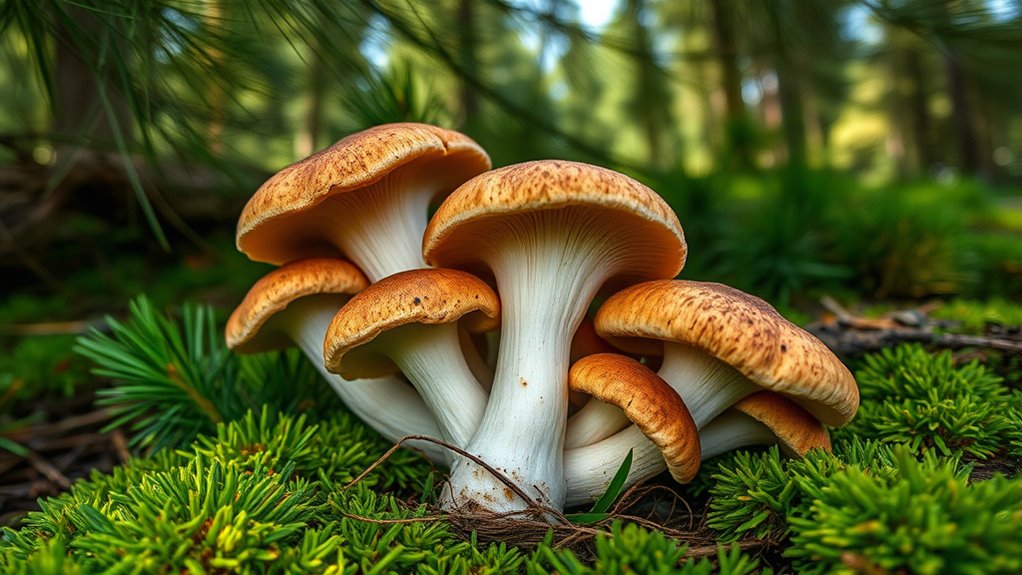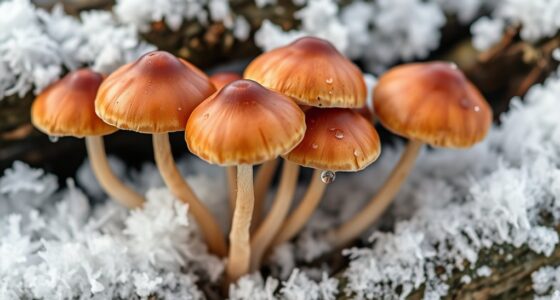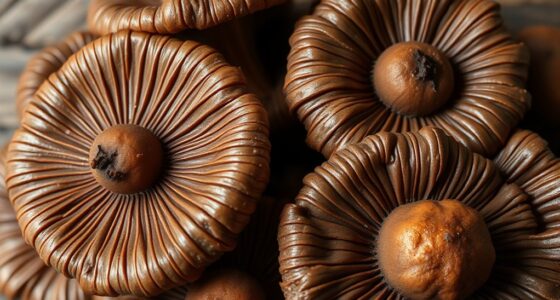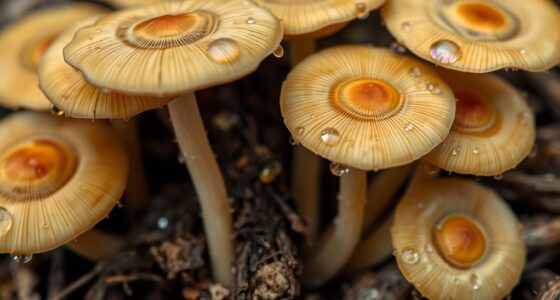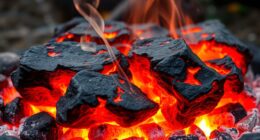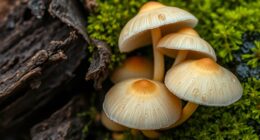To find matsutake mushrooms, focus on their distinctive pine-like aroma that stands out among forest fungi. They favor shady, well-drained soils under pine trees, often hidden beneath fallen pine needles. Spotting these mushrooms involves paying close attention to their unique scent and habitat. Mastering these clues boosts your chances of success. Keep exploring, and you’ll uncover more tips that will sharpen your foraging skills and deepen your connection with nature.
Key Takeaways
- Matsutake mushrooms emit a unique pine and spicy aroma that aids in their identification during foraging.
- They thrive in shady, well-drained soils beneath pine trees, often hidden under pine needles.
- Habitat knowledge increases foraging success by focusing on pine forests during peak seasons.
- Recognizing the mushroom’s distinctive scent and habitat enhances the ability to locate mature specimens.
- Seasonal timing, mainly late summer to early autumn, aligns with the mushroom’s natural appearance in pine habitats.
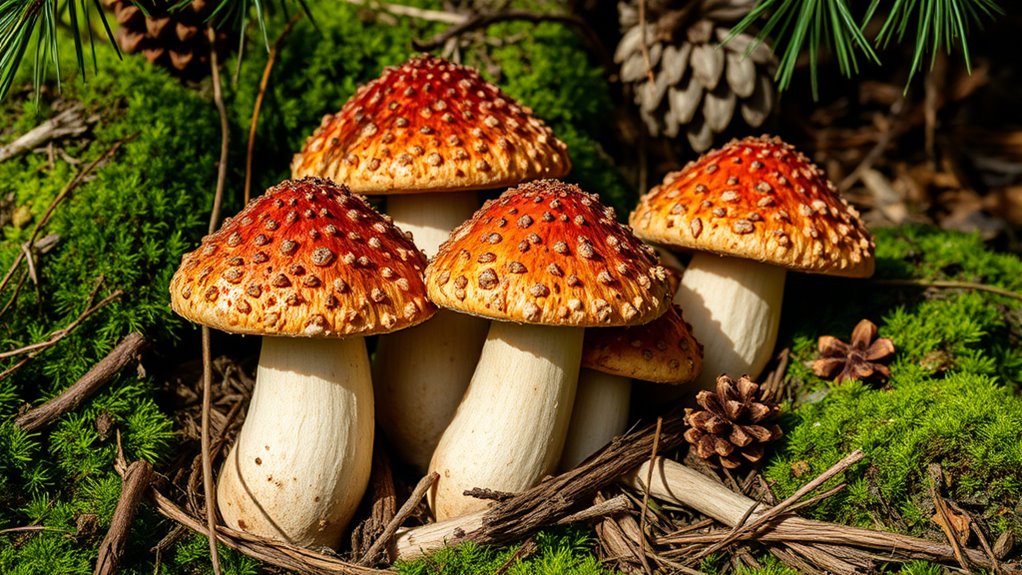
Have you ever wondered what makes foraging for matsutake so exciting? It’s the thrill of the hunt—tracking down these elusive fungi in their natural pine habitats, feeling the rush as you spot that unmistakable mushroom nestled among the needles. Matsutake isn’t just a mushroom; it’s a symbol of seasonal harvesting, a fleeting treasure that appears only at specific times of the year. When the season arrives, usually in late summer to early autumn, you seize the opportunity to gather these prized fungi, knowing that each one you find is a victory against the odds. This seasonal rhythm keeps foraging fresh and invigorating, reminding you of nature’s fleeting beauty and bounty. The distinctive aroma is a key factor that helps identify mature matsutake, highlighting the importance of understanding its characteristics and habitat preferences.
Your journey into matsutake foraging isn’t complete without understanding its culinary uses. Once harvested, these mushrooms transform into extraordinary dishes—aromatic stews, grilled delicacies, or simply sliced raw to savor their unique pine and spice aroma. Their distinctive fragrance is what sets matsutake apart, offering a sensory experience that’s both earthy and invigorating. When you bring them home, you hold the power to elevate simple ingredients into gourmet creations, celebrating the mushroom’s rich flavor and aroma. This connection between foraging and culinary artistry gives you a sense of liberation—an act of reclaiming your food source, of transforming nature’s gifts into something truly special.
Once harvested, matsutake elevates dishes with its distinctive pine and spice aroma, transforming simple ingredients into gourmet creations.
The aroma of matsutake is its signature trait, a piney, spicy scent that instantly transports you to the forest’s depths. It’s a fragrance that can’t be replicated, making each mushroom a treasure that’s worth seeking out. As you walk through the pine groves, pay close attention to the environment—matsutake prefers shady, well-drained soils beneath pine trees, often hiding beneath fallen needles. The hunt is about more than just finding the mushroom; it’s about immersing yourself in the wilderness, feeling a deep connection to the land and the seasons. When you finally spot that white, stout mushroom emerging from the forest floor, the moment feels pure and freeing. It’s a reminder that nature’s abundance is there for those willing to explore and respect its rhythms.
In the end, foraging matsutake isn’t just about gathering; it’s an act of reclaiming your relationship with the wild. It’s about embracing the season, savoring the aroma, and unleashing your culinary creativity with each find. When you master the art of seasonal harvesting, you open yourself to a world of flavors and freedom—where the forest’s secrets become your own.
Frequently Asked Questions
How Can I Determine the Best Time to Forage for Matsutake?
You should forage for matsutake when seasonal indicators signal their arrival, typically in late summer to fall. Keep an eye on weather patterns—warm days followed by cool, damp nights create ideal conditions. When you notice the pine forests releasing their distinct aroma and the ground’s moisture levels rise, it’s time to head out. Trust your senses and embrace the thrill of harvesting these elusive, fragrant mushrooms at their peak.
Are There Any Look-Alike Mushrooms That Are Toxic?
Yes, some look-alike species can cause toxic confusion when foraging for matsutake. You might encounter false matsutake or other white or brown mushrooms that resemble the real deal but are poisonous. To stay safe, learn to identify key features like gill structure, stem texture, and scent. Always double-check with expert guides or local foraging groups, and never consume a mushroom unless you’re absolutely certain of its identity.
What Tools Are Essential for Safe Foraging?
To guarantee safe foraging, you need essential tools like a sharp knife for mushroom identification and cutting, a wicker basket to keep mushrooms fresh, and a field guide to distinguish edible from toxic varieties. A small brush helps clean specimens, while a notebook records your findings. Always carry a flashlight for low light conditions. These tools empower you to enjoy foraging safely, embracing your freedom to explore nature confidently and responsibly.
How Should I Store Matsutake After Harvesting?
You should store matsutake like a treasure chest—cool, dry, and vented! Use paper bags or wrap them in a paper towel and keep them in the fridge to preserve their exquisite aroma. Avoid plastic, which traps moisture and spoils the magic. For longer preservation, drying or freezing works wonders, revealing the mushroom’s true potential. Embrace these storage tips and unleash the full flavor of your wild bounty!
Can I Forage Matsutake Sustainably Without Damaging the Habitat?
Yes, you can forage matsutake sustainably by practicing habitat conservation and mindful harvesting. Always pick only mature mushrooms, leaving younger ones to spore and grow, and avoid overharvesting in a single area. Stick to established foraging guidelines, respect protected zones, and minimize disturbance to the pine forests. This way, you support the ecosystem, ensuring future generations can also enjoy the thrill of harvesting these prized mushrooms.
Conclusion
If you venture into the pine forests for matsutake, you’re opening a treasure chest of unparalleled aroma and flavor. With just a whiff, you’ll swear you’ve discovered the secret of the forest itself—an elusive, mystical scent no other mushroom can match. So don’t just walk past those pine trees; immerse yourself and claim this legendary delicacy. Trust me, once you taste matsutake, you’ll be chasing that divine aroma forever—it’s that unforgettable.

